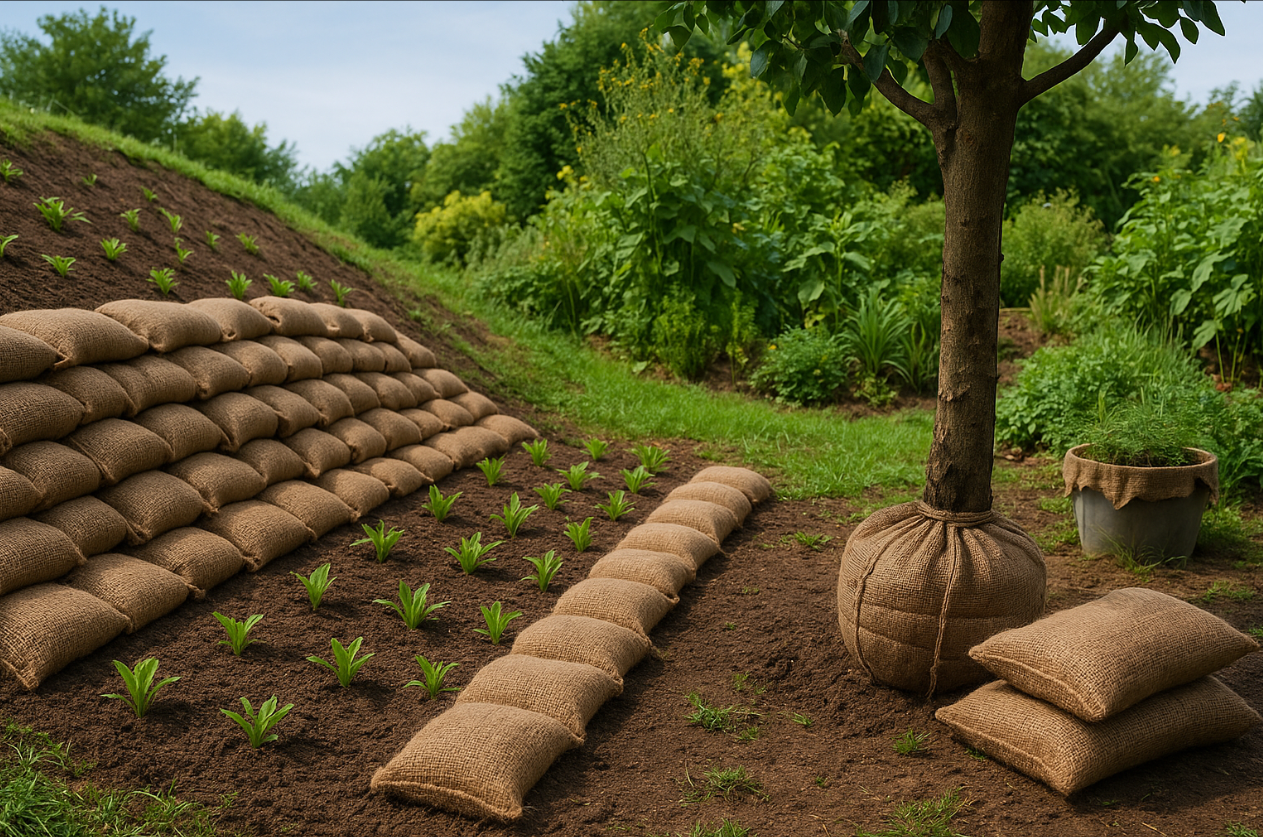- July 17, 2025
- Posted by: wellcoindustries
- Categories: Burlap, Erosion Control
Introduction
A spring storm in 2025 turned the clay bank behind my client’s retail greenhouse into a chocolate waterfall. I hustled back the next morning with a bundle of burlap bags for landscape work, filled them with sandy loam, and stacked a quick check dam. By the next rain, seedlings were sprouting through the weave—bank saved, runoff tamed. That one‑hour fix is why sustainable pros keep burlap in the truck. Made from rapidly renewable jute, burlap breathes, decomposes naturally, and—thanks to vertically integrated suppliers like Wellco Industries, which has 20 years of global distribution and ISO 9001 manufacturing—arrives on‑site in consistent, contractor‑grade quality.

Why Burlap Bags Matter in Modern Landscaping
Natural & Biodegradable Advantage
Jute crops mature in just four months, sequestering up to 13 t CO₂ per hectare while needing little fertilizer.1 When the job is done, burlap breaks down into organic matter within a season, so projects avoid micro‑plastic pollution and landfill fees.
Cost and Performance vs. Synthetic Alternatives
The 2025 ASLA Cost Benchmark Report shows burlap erosion blankets averaging 34 % lower installed cost than polypropylene netting on 2:1 slopes, while matching germination rates at 95 %. 2
10 Smart Uses of Burlap Bags for Landscape Projects
1. Erosion Control on Slopes
Fill bags with a sand‑soil mix, stake along contours, and let turf roots stitch everything together.
2. Root Ball Wrapping for Tree Transplanting
Breathable burlap reduces heat buildup; GreenCity Tree Care boosted survival from 78 % to 92 % after switching. 3
3. Frost Protection for Tender Shrubs
Slip empty bags over hydrangeas; the trapped air layer buffers temperatures by ~4 °C.
4. Weed‑Suppressing Mulch Layer
Lay flattened bags, top with 5 cm compost—university trials cut weed pressure 70 %. 4
5. Sandbag Barriers for Flood Mitigation
Stacked burlap absorbs water, swells, and molds to rough terrain—ideal for protecting fresh hardscape.
6. Compost‑Tea Brewing Sacks
Fill with finished compost, steep 24 h in a 200 L drum, and fertigate beds with microbe‑rich tea.
7. Raised‑Bed Liners for Soil Retention
Line timber boxes to keep fines in while still allowing drainage.
8. Protecting Hardscape Materials in Transit
Wrap pavers or bluestone to prevent scratches and wick condensation.
9. Temporary Pathways During Construction
Pin filled bags two wide for mud‑free OSHA‑compliant walk zones.
10. DIY Rustic Planters & Garden Art
Fold, sew, and lime‑wash for low‑cost pop‑up displays.
How to Choose High‑Quality Burlap Bags
Key Specs: Weight, Weave Density, Treatments
| Spec | Recommended Range | Why It Matters |
|---|---|---|
| Weight | 7–10 oz / yd² | Balance of strength and drape |
| Weave | 9 × 9 yarns / in | Resists tear‑out on slopes |
| Treatment | Food‑grade CaCO₃ rinse | Low odor, +20 % outdoor life |
Supplier Checklist: Certifications & Private‑Label Options
“Always verify ISO 9001 and OEKO‑TEX® Standard 100 compliance to ensure fiber purity and colorfastness,” advises Dr. Carlos Mendez, EcoBuild Labs.
Wellco Industries offers pallet‑level QC, private‑label printing, and global just‑in‑time shipping—capabilities prized by distributors and OEM brands.
Case Study: County Park Renovation Cuts Runoff 35 % with Burlap
Project Overview & Goals
Pine Meadow Park (Midwest USA) faced shoreline erosion undermining trails. Designers specified 4,500 burlap‑bag check dams filled with gravel.
Measured Outcomes & Savings
After one rainy season, creek turbidity dropped 35 %, maintenance hours fell by 42, and the county saved US $18,600 in disposal costs by tilling used burlap into the soil.5
Installation & End‑of‑Life Best Practices
Safe Handling and Storage Guidelines
-
Store bags dry, off the ground, under cover to prevent mold.
-
Wear gloves—coarse jute fibers can abrade skin.
Regulatory & Safety Notes
-
ASTM D6981: Follow water‑filled‑bag guidelines for flood control.
-
USDA Organic: Untreated jute fiber is permissible as mulch.
-
Local Stormwater Codes: Burlap check dams often qualify as temporary sediment control—verify with inspectors.
Composting and Soil Amendment Tips
Shred used bags and incorporate into the top 15 cm of soil; nitrogen draw‑down is minimal and tilth improves within weeks.
Conclusion
From stabilizing slopes to crafting rustic planters, burlap bags for landscape tasks deliver sustainability, savings, and proven field performance. With two decades of manufacturing experience and a global logistics network, Wellco Industries ensures every bale meets spec and arrives when the crew needs it. Ready to spec burlap on your next project? Request technical data sheets and custom sizing today.
Frequently Asked Questions
Q1. How long do burlap bags last outdoors before degrading?
Uncoated 9 × 9 burlap typically holds structural integrity for 6–12 months, depending on UV exposure and moisture, after which it gradually decomposes.
Q2. Can I use burlap bags in certified organic gardens?
Yes—untreated jute burlap is permissible under USDA Organic rules as mulch or weed barrier.
Q3. Will burlap leach chemicals into soil or water?
Food‑grade burlap is processed without harmful dyes; always check OEKO‑TEX® certification to confirm safety.
Q4. Do sand‑filled burlap bags meet flood‑control regulations?
Most jurisdictions accept them when filled and stacked per ASTM D6981; confirm with local emergency‑management guidelines.
Q5. Does Wellco Industries offer custom printing for private‑label programs?
Absolutely—Wellco can print logos or instructions on bags in up to three colors with low minimum order quantities.
International Jute Study Group, Jute & Climate Report, 2024. ↩ American Society of Landscape Architects, Cost Benchmark Report, May 2025. ↩ GreenCity Tree Care internal transplant audit, Q1 2024. ↩ Midwest State University Vegetable Trials Bulletin #233, 2023. ↩ Pine Meadow County Engineering Dept., Shoreline Restoration Summary, March 2025. ↩Footnotes
